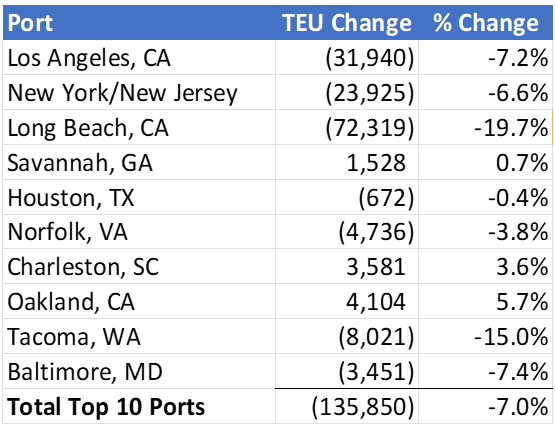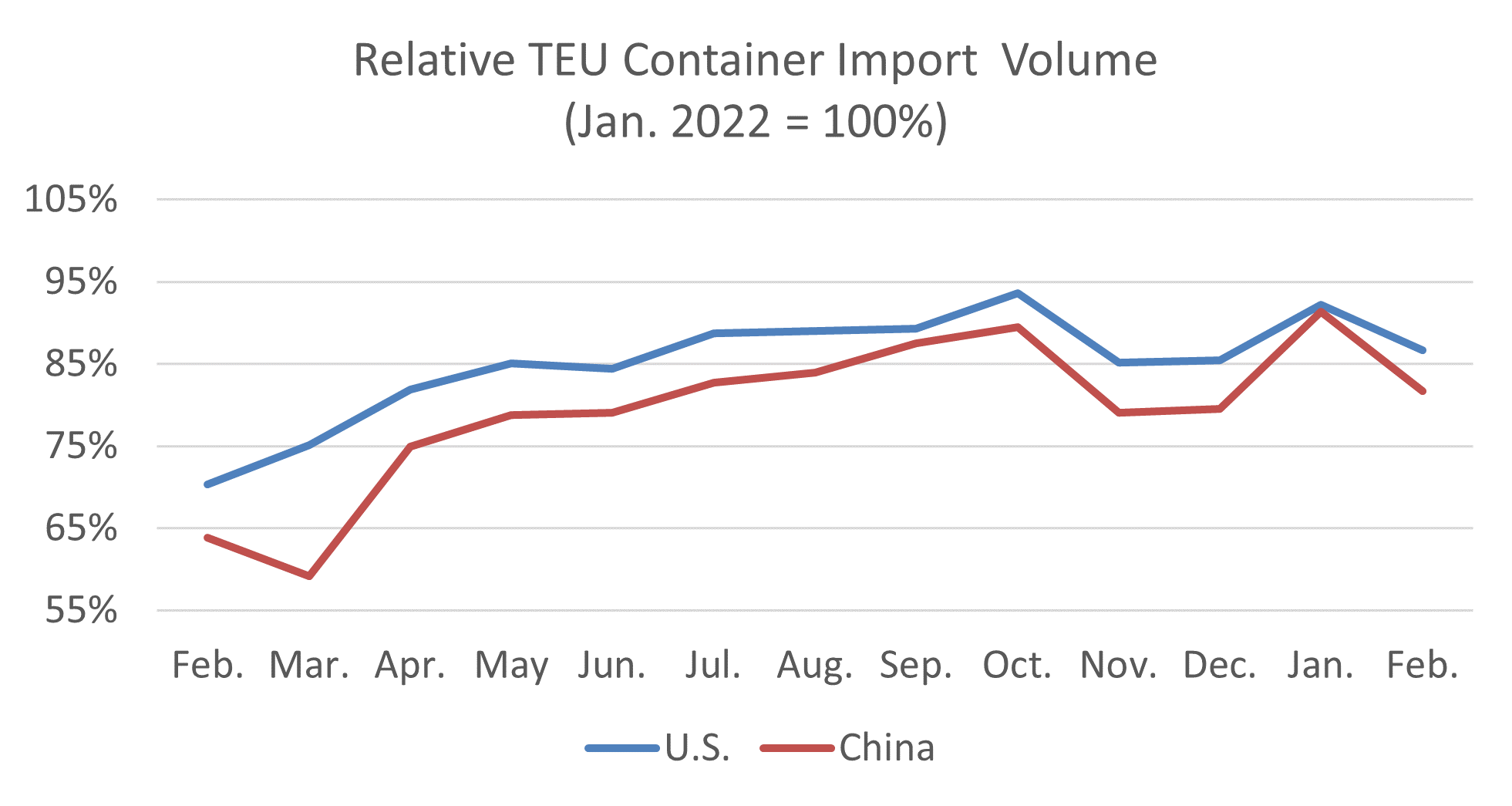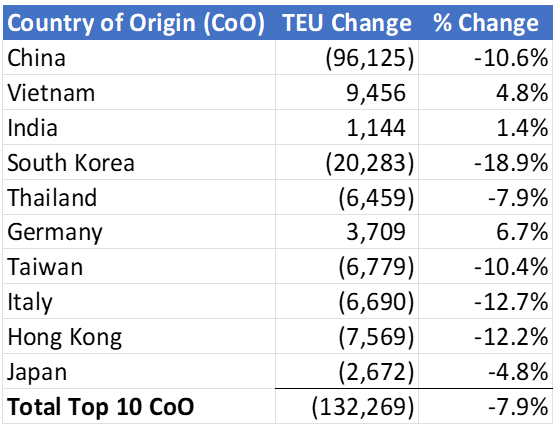The Global Shipping Report
February U.S. Import Container Volume Continues Strong Performance
In February 2024, U.S. container import volumes declined 6% from January, but jumped 23.3% when compared to the same month last year. We would expect the month-over-month results to be smaller as February is a shorter month. The year-over-year results would indicate exceptional growth; however, they do not take into account the impact of the Chinese Lunar New Year on the February 2023 results. The growth is still strong but, based upon Descartes’ analysis, it is more likely to be ~13%, which is further explained below.
Compared to January 2024, imports from China reversed their robust growth in February, which impacted West Coast ports—especially the Port of Long Beach. Lower import volumes benefitted port transit delays as the combination of the Panama drought and Middle East conflict had less impact at the top East and Gulf Coast ports. The March update of the logistics metrics Descartes is tracking shows that 2024 is starting off to be a strong year for U.S. container imports; however, global supply chain performance may be impacted throughout the year because of ongoing conditions at the Panama and Suez Canals and upcoming labor negotiations at U.S. South Atlantic and Gulf Coast ports.
In this Article...
- U.S. container imports show strong growth.
- East and Gulf Coast ports regained market share lead with declines at the Ports of Los Angeles and Long Beach.
- February port transit delays decreased overall, especially at East Coast ports.
- Trade lanes less impacted by the effects of the Panama drought and Middle East conflict in February 2024.
- Potential labor disruption at South Atlantic and Gulf Coast ports in 2024.
- Managing supply chain risk: what to watch in 2024.
- Consider recommendations to help minimize global shipping challenges.
U.S. container imports show strong growth.
February 2024 U.S. container import volumes decreased 6.0% from January 2024 to 2,137,724 twenty-foot equivalent units (TEUs) (see Figure 1). Versus February 2023, TEU volume was higher by 23.3%, and up 19.5% from pre-pandemic February 2019. There are several reasons for the sharp year-over-year increase that could overstate this February’s results. Leap year occurred in 2024, adding one day of capacity in February. In addition, Chinese Lunar New Year occurred on February 11 this year versus January 22 in 2023, so February 2024 saw no impact on U.S. imports from China while February 2023 did. To gain more clarity on the year-over-year performance, Descartes analyzed TEU volume for the first 15 days in February of both years where there would be no impact from Chinese Lunar New Year. During this timeframe, the growth in container imports was 13.3%, which is much more representative. Overall, Figure 1 shows that the first two months of 2024 are more in line with the consumer-fueled pandemic growth.
Figure 1: U.S. Container Import Volume Year-over-Year Comparison

Source: Descartes Datamyne™
In the previous six years, comparing January to February, import volume varied from smaller declines to larger ones (see Figure 2) with the timing of Chinese Lunar New Year measurably impacting month-over-month container import volumes (Chinese Lunar New Year: 2024: February 11, 2023: January 22, 2022: February 1, 2021: February 12, 2020: January 25, 2019: February 5 and 2018: February 16). Given the strength of January’s import volume, February’s 6.0% reduction was similar to other high volume months, such as February 2022, where there was no impact from Chinese Lunar New Year.
Figure 2: January to February U.S. Container Import Volume Comparison

Source: Descartes Datamyne™
For the top 10 U.S. ports, container import volume in February 2024 was down significantly by 135,850 TEUs (-7.0%) versus January 2024 (see Figure 3). The Port of Oakland (4,104 TEUs) and Charleston (3,581 TEUs) experienced the greatest container volume increases from January, while the ports of Long Beach (--72,319 TEUs), Los Angeles (-31,940 TEUs) and New York/New Jersey (-23,925 TEUs) posted the most significant decreases.
Figure 3: January 2024 to February 2024 Comparison of Import Volumes at the Top 10 U.S. Ports

Source: Descartes Datamyne™
Chinese imports in January also significantly decreased and were down by 10.6% from January 2024 to 809,048 TEUs, widening the gap (now -19.4%) from the August 2022 high (see Figure 4). Even with the January to February slowdown, the top two commodity codes (HS-2s) continued to be consumer-oriented goods such as HS-94 (Furniture, Bedding, etc.), HS-39 (Plastics and Articles Thereof). China represented 37.8% of the total U.S. container imports in February, a decrease of 2.0% from January, and down 3.7% from the high of 41.5% in February 2022.
Figure 4: January 2023 – January 2024 Comparison of U.S. Total and Chinese TEU Container Volume

Source: Descartes Datamyne
For the top 10 countries of origin (CoO), U.S. container import volume in February 2024 retreated 7.9% (-132,269 TEUs) from the previous month, with China having the greatest volume decrease (-96,125 TEUs) and Vietnam (9,456 TEUs) having the largest volume increase (see Figure 5).
Figure 5: December 2023 to January 2024 Comparison of U.S. Import Volumes from Top 10 Countries of Origin

Source: Descartes Datamyne
East and Gulf Coast ports regained market share lead with declines at the Ports of Los Angeles and Long Beach.
In February 2024, the volume share at top West Coast ports decreased based on significant volume losses at the Ports of Los Angeles and Long Beach. Comparing the top five West Coast ports to the top five East and Gulf Coast ports in February 2024 to January 2024 shows that, of the total import container volume, top West Coast ports decreased to 40.5% (down 2.5%) and top East and Gulf Coast ports increased to 44.0% (up 1.6%). Compared to smaller ports, the top 10 ports’ share in February 2024 decreased to 84.5%, down slightly (0.9%) versus January 2024 (see Figure 6).
Figure 6: Volume Analysis for Top Ports, West Coast Ports and East and Gulf Coast Ports

Source: Descartes Datamyne
February port transit delays decreased overall, especially at East Coast ports.
Overall port transit delays in February 2024 decreased across the top ports (see Figure 7), except for the Ports of Oakland and Tacoma, which increased. The top East Coast ports decreased with the Port of Houston seeing the greatest transit delay decrease (1.8 days).
Figure 7: Monthly Average Transit Delays (in days) for the Top 10 Ports (Nov. 2023 – Jan 2024)

Source: Descartes Datamyne™
Note: Descartes’ definition of port transit delay is the difference as measured in days between the Estimated Arrival Date, which is initially declared on the bill of lading, and the date when Descartes receives the CBP-processed bill of lading.
Trade lanes less impacted by the effects of the Panama drought and Middle East conflict in February 2024.
There is no change in the Panama Canal situation as the drought continues to affect traffic flow. The number of transit slots increased slightly in January 2024 to 24, up two from December 2023, but well below normal operations of 36 slots. The attacks on shipping in the Red Sea by the Houthi from Yemen have diverted cargo that would traditionally move through the Suez Canal.
Despite ongoing capacity constraints at the Panama Canal, volume at Gulf Coast ports remains stable and, considering that February was a shorter month, performed better than either of the other two coasts (see Figure 8). Versus January 2024, February 2024 Gulf Coast container import volumes were up 1.0% to 225,858 TEUS. The slightly lower East Coast port volume in February 2024 versus January 2024 translated into lower port transit time delays despite continued reductions in traffic through the Panama Canal and avoidance of the Suez Canal. More stable volumes at Gulf Coast ports also shortened delays, as port transit times decreased by ~2 days.
Figure 8: February 2023 to January 2024 U.S. Gulf Coast Container Imports

Source: Descartes Datamyne™
To access other articles that track port congestion monthly, visit the
Global Shipping Resource Center
White Papers
Survey Uncovers Supply Chain Strategies of Top Performing Companies
Surviving Peak Season and Beyond: The Essential Guide to Supply Chain Resiliency

Executive Vice President of Industry and Services
Descartes Systems Group
The Must-Read Guide on U.S. Maritime Ports

See the impact port congestion has had on U.S. imports, and gain insights into how to mitigate risks in your supply chain.
Stay Informed. Download the Report.
Potential labor disruption at South Atlantic and Gulf Coast ports in 2024.
The agreement between the International Longshoremen’s Association (ILA) and United States Maritime Alliance (USMX) is set to expire at the end of September 2024. Labor action would disrupt operations at South Atlantic and Gulf Coast ports. ILA leadership has stated that it will not extend the current agreement and told members to prepare for the possibility of a coast-wide strike in October 2024. There are still no statements of progress from either organization.
Managing supply chain risk: what to watch in 2024.
U.S. container import volume decreased in February 2024 yet continued to surpass 2019 numbers for the same period. The economy is still exceeding expectations, which indicates healthy import volumes. However, challenges with the Panama drought, Middle East conflict and pending ILA contract negotiations point to further trade flow disruptions. Here’s what Descartes will be watching in 2024 to see if global supply chain performance will continue to improve:
- Monthly TEU volumes between 2.4M and 2.6M. This level will continue to stress ports and inland logistics until infrastructure can be enhanced. February U.S. container import volumes were down to 2.1M TEUs, which puts less pressure on ports.
- Port transit wait times. If they decrease, it’s an indication of improved global supply chain efficiencies capabilities or that the demand for goods and logistics services is declining. February port transit times decreased on all coasts with East and Gulf Coast ports still experiencing the longest delays.
- Continuing impact of the pandemic. The spread of COVID subvariants continues to add uncertainty to the trajectory of the pandemic and impact supply chains in unpredictable ways as different countries are affected at different times and for different durations. Another new variant of COVID is causing infection rates to rise, which has not yet impacted supply chains and logistics resources but needs to be watched throughout the year.
- The economy. The U.S. is an import-driven economy, so economic health is an important indicator of container import volumes. However, there are many indicators that continue to provide conflicting stories. As of March 4, the Federal Reserve borrowing rate remained at 5.3% to slow inflation which was up slightly to 3.9% (as of January). The jobs growth numbers continue to exceed analysts’ expectations. Yet, consumers continue to spend as the inflation adjusted personal consumption expenditures of durable goods was down slightly in January (latest available numbers), but still near the high for the last two years.
- Panama Canal-based trade flow. The combination of the drought impacting capacity and the recently ratified International Longshore and Warehouse Union (ILWU) could accelerate the redirection of the one million TEUs that shifted from the West Coast ports during the pandemic. Container volume in February at top East Coast ports was down slightly while top Gulf Coast Ports grew slightly. Top East and Gulf Coast port transit times decreased.
- Middle East conflict. Attacks on shipping in the Red Sea by Houthis from Yemen could cause carriers to forego the Suez Canal, extending transit times and negatively impacting global shipping capacity. The impact of diversions away from the conflict is still minimal on volumes or transit delays for the East and Gulf Coast ports.
- ILA/USMX contract negotiation. A potential strike on the South Atlantic and Gulf Coasts could disrupt U.S. container imports later in 2024. Given the current Panama Canal situation, shifting volume to West Coast ports could be extremely challenging or significantly extend transit times. No progress was cited in February.
Consider recommendations to help minimize global shipping challenges.
February 2024 U.S. container import volumes were lower compared to January 2024, but ~13% higher compared to “normalized” February 2023 numbers. Overall port transit times in February were lower than January results. Ongoing issues in Panama and the Middle East are creating pressure on global supply chains that could cause disruptions throughout 2024. Descartes will continue to highlight key Descartes Datamyne, U.S. government and industry data in the coming months to provide insight into global shipping. Recommendations remain unchanged from Descartes’ February Global Shipping Report.
Short-term:
- Track the spread of COVID variants to determine when they will hit critical parts of the supply chain, especially in China.
- Track ocean shipments and carrier performance as there is still a considerable gap between original ETAs and actual ones.
- Track the Panama Canal situation as the drought may impact shipping capacity and timeliness and even cause rerouting of supply chains.
- Track the Middle East conflict as carriers have begun to divert shipping around Africa, and this will impact shipping capacity and timeliness.
- Evaluate the impact of inflation and the Russia/Ukraine and Israel/Hamas conflicts on logistics costs and capacity constraints. Ensure that key trading partners are not on sanctions lists.
- Evaluate the potential impact of an ILA strike in October 2024 on South Atlantic and Gulf Coast ports to determine alternate ports or trade lanes.
Near-term:
- For companies importing from Asia, reevaluate trade that was moved away from West Coast ports.
- For companies that have cargo moving through the Suez Canal, evaluate the impact of extended rerouting.
Long-term:
- Evaluate supplier and factory location density to mitigate reliance on over-taxed trade lanes and regions of the globe that have the potential for conflict. Density creates economy of scale but also risk, and the pandemic and subsequent logistics capacity crisis highlights the downside. Conflicts do not happen “overnight” so now is the time to address this potentially business disrupting issue.
Note: This report uses the initial compiled release of U.S. Customs and Border Protection (CBP) data and is subject to revision later by CBP. The revised data can be seen in Descartes Datamyne.
How Descartes Can Help
Descartes Datamyne delivers business intelligence with comprehensive, accurate, up-to-date, import and export information.
Our multinational trade data assets can be used to trace global supply chains and our bill-of-lading trade data – with cross-references to company profiles and customs information – can help businesses identify and qualify new sources. Ask us for a free, no obligation demonstration of our data on a product or trade commodity of your choosing – and keep the custom research we create with our compliments.

